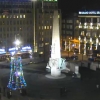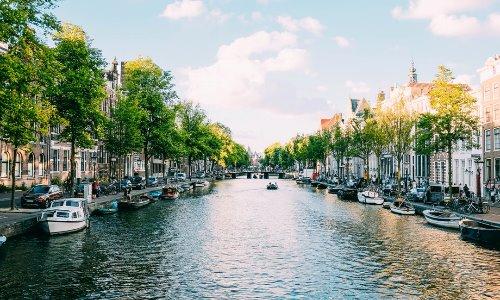The most populous city in the Kingdom of the Netherlands and the Dutch capital, Amsterdam although not the seat of the Dutch government The Hague, is mandated by the Constitution of the Netherlands. Within its city limits Amsterdam has a total population of 813,562, 1,575,263 in the metropolitan area and 1,112,156 within its urban region. Amsterdam is located west of the country in the Netherlands province of North Holland situated on the North Sea and comprises of much of the northern territory of the Randstad, one of Europe’s larger conurbations consisting of four cities with a total population of over 7 million.
Originally a small fishing village during the 12th century the name Amsterdam was derived from Amsteiredamme suggestive of the origin of the city used as a dam of the River Amstel which runs through the city. Later during the 17th century often referred to as the Dutch Golden Age with the innovative developments in trade Amsterdam was transformed into one of the world’s most important ports. During the 19th and 20th century Amsterdam expanded with building of several neighborhoods and planned suburbs. In recognition the UNESCO World Heritage Site has listed the 17th-century canals of Amsterdam and the Defense Line of Amsterdam among the list of sites offering outstanding cultural or natural importance to the common heritage of humanity.
One of the major financial capitals throughout Europe and the commercial capital of the Netherlands Amsterdam is acknowledged by the Globalization and World Cities study group as an alpha world city. Several major Dutch corporations are headquartered in Amsterdam among seven of the world’s 500 largest companies including, the Dutch multinational banking and financial services corporation the ING Group and the Dutch diversified technology company Royal Phillips. The Economist Intelligence Unit in 2012 ranked Amsterdam as the second most suitable place to live. The famous diarist Anne Frank, and the renown artist Vincent Van Gogh are just some of the well known persons who have lived in Amsterdam.
Interesting Facts about Amsterdam
- Within Amsterdam’s City center is the world’s oldest stock exchange along with several other main attractions which include, Anne Frank House, the Amsterdam Museum, the cannabis coffee shops which attract over three million international visitors annually, the Hermitage Amsterdam, the Van Gogh Museum, its historic canals and the red-light district.
- Following the 1170 and 1173 floods Amsterdam residents built a bridge over the river as well as a dam across, ergo the name of the village; “Aemsteiredamme”. This is the earliest documented use of the name “Aemsteiredamme”. Notably residents in the County of Holland by the Count of Holland and Zeeland Count Floris V. were exempt from paying a toll for using the bridge. This allowed the residents in Amesteiredamme to move freely throughout Holland without subject to pay toll at bridges, dams and locks.
- On May 10, 1940 Germany invaded the Netherlands and took control of the country. Many residents provided shelter for Jews thus exposing their families to the danger of being caught, sent to concentration camps or even killed. Over 100,000 Dutch Jews were sent to Nazi concentration camps of which approximately 60,000 lived in Amsterdam, the most famous of whom was a young Jewish girl by the name of Anne Frank who later died in the Nazi concentration camp Bergen-Belsen which is today Lower Saxony in northern Germany.
- Amsterdam with over 176 nationalities contains one of the most diversified population than any other city in the world and boasts a shared population of immigrant ancestry of almost 50%. Occasionally Amsterdam is characterized by its racial tension. In 2004 the film director Theo van Gogh was assassinated by a Dutch-Moroccan Islamist Mohammed Bouyeri
- To the east of Denmark you will find the oldest area of the city known as de Wallen which is famous for its red light district and south of which lies the old Jewish quarter of Waterlooplein.
- Amsterdam’s canal system was created by virtue of conscious urban planning. When immigration was at its peak during the 17th century a plan was conceived for creating a waterfront and was based on the development of four coordinated semicircle canals which would emerge from the IJ Lake in the Dutch province of North Holland. Three of the canals, the Herengracht, the Keizersgracht and the Prinsengracht were known as the Grachtngordel and were recognized primarily for residential development. The Singlgracht which is the fourth and outmost canal is seldom mentioned due to its collective name for the all canals located in the outer ring. The canals were used mostly for transport, water management, and for defense.
- Amsterdam’s oldest building is the Oude Kerk, translated Old Church, consecrated in 1306 and located at the center of the Wallen. The city’s oldest and one of its only two wooden buildings the het Houten Huys lies in one of the oldest inner courts in the city known as the Begijnhof which today is also the site of the English Reformed Church. Notably the het Houten Huys is one of the few examples of Amsterdam’s Gothic architecture.
- Amsterdam contains several open spaces and park squares scattered throughout the city. The largest of which is the Vondelpark public urban park in the Oud-Zuid borough consisting of over 120 acres and was named in honor of the 17th century Amsterdam author, Joost van den Vondel. Vondelpark hosts over 10 million visitors annually and features an open-air theatre, a playground and a number of horeca facilities which prepare and serve food and drinks.
- With more than 4 million international visitors annually, Amsterdam is one of the most sought after tourist destinations throughout Europe. Many of the hotels located in Amsterdam can be found within the center of the city of which 42% are considered four to five star hotels. Most of the tourists who visit Amsterdam originate from Europe while the largest group of non-European visitors generally come from the United States and account for an estimated 14% of Amsterdam’s annual visitors. In 2006 to attract more visitors Amsterdam celebrated the 400th birthday of the Dutch painter and etcher Rembrandt Harmenszoon van Rujn.
- One of the oldest areas in Amsterdam with an architecture layout typical of 14th century Amsterdam, De Wallen is best known for its legalized prostitution, ergo the name, “Red-light district”. The area is famed for attracting visitors and consists of a network of roads and alleys boasting several rooms rented by prostitutes who sell their services from behind a window or glass door. De Wallen also contains several peep shows, a sex museum, sex theatres, a cannabis museum and a few coffee shops known for selling marijuana.
Amsterdam Webcams
Dam Square Amsterdam webcamLocated neat the NH Grand Hotel Krasnapolsky, this webcam offers a live video of the center of Dam Square dominated by the Dam Monument to the right.
View Amsterdam Webcams.
The Amstel Canal Amsterdam webcam
The Amstel Canal Amsterdam webcam by way of EarthCam is located at the Hotel Nes in the heart of the city and displays an amazing view of the Amstel Canal.
View The Amstel Canal Amsterdam webcam.
Overtoom TV Amsterdam Cam
Live webcam located on the street level of the main roads in Amsterdam – the Overtoom. Watch cars and people going by and more. There are three webcams to choose from and images update every few seconds.
View Live Webcam: Overtoom TV Amsterdam Cam

Live Amsterdam Netherlands Webcam
This is an excellent, high quality HD webcam that gives various views of Amsterdam, Netherlands. Streaming video with preset remote controls.
View Live Webcam: Live Amsterdam Netherlands Webcam

